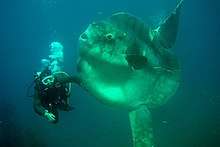Mola alexandrini
The southern sunfish (Mola alexandrini[3]), also known as the Ramsay's sunfish, southern ocean sunfish, short sunfish or bump-head sunfish in many parts of the world,[4] is a fish belonging to the family Molidae. It is closely related to its congener, much wider known Mola mola, and is found in the Southern Hemisphere.[5] It can be found basking on its side occasionally near the surface, which is thought to be used to re-heat themselves after diving in cold water for prey, recharge their oxygen stores, and attract gulls to free them of parasites.[2]
| Mola alexandrini | |
|---|---|
.jpg) | |
| Scientific classification | |
| Kingdom: | Animalia |
| Phylum: | Chordata |
| Class: | Actinopterygii |
| Order: | Tetraodontiformes |
| Family: | Molidae |
| Genus: | Mola |
| Species: | M. alexandrini |
| Binomial name | |
| Mola alexandrini | |
| Synonyms | |
Taxonomy
In December 2017, it was demonstrated that Mola alexandrini may be a senior synonym of Mola ramsayi (Ranzani 1839) through both historically and newly published morphological data.[6]

The ocean sunfish are in the genus Mola, currently composed of three species: Mola mola, Mola alexandrini, Mola tecta. Mola alexandrini was seen in the Oman Sea near Iran for the first time in August 2013 (Yasemi and Narari Bejgan, 2013). Also known as the southern ocean sunfish or southern sunfish, Mola alexandrini are commonly found in the epipelagic zone of the ocean which is the part of the ocean where enough light penetrates for photosynthesis to occur (Matsuura, 2002) although recent studies also suggest that the sunfish are more common in deep waters than previously thought (Phillips et al. 2015).
Description
Mola alexandrini has a relatively small mouth and its teeth fused into a parrot-like beak. It can reach up to 3.3 m (11 ft) in length and 2,300 kg in mass, making it one of the two heaviest bony fish on earth.[7] Their body is flat and round, with large fins that they swish back and forth to propel themselves with as they swim horizontally. Their skin has rough denticles, leathery texture, with brown and gray coloring with pale blotches until death when they turn white.[3] Both mola species have no caudal bones, ribs, and pelvic fins and have fused vertebrae, leaving only their median fins to propel themselves.[8] It can be recognized from the Mola mola by their lesser number of ossicles and lacking the vertical band of denticles at its base.[4]

The fish of the family Molidae are characterized by their compressed shape, fused teeth, absence of spines in dorsal and anal fins, and a short caudal fin (Yasemi and Narari Bejgan, 2013) and can grow to great sizes.
M. alexandrini was found to be synonymous with M. ramsayi in July 2017 and can be distinguished by their unique characteristics of head bump, a chin bump, rectangular body scales, and rounded clavus. Although adult sunfish look generally similar, they are distinguishable using the seven characteristics: number of clavus fin rays (Yoshita et al 2009), number of clavus ossicles (Yoshita et al 2009), shape of clavus margin (Yoshita et al 2009), presence of head bump (Yoshita et al 2009), proportion of body length compared to body height (Yoshita et al 2009), shape of body scales (Fraser-Brunner 1951), and the presence of a chin bump (Sawai et al. 2017).
Mola alexandrini can be distinguished from Mola mola by a getaway bump on its chin and noticeable bump on its head and a differently looking tail, which is more rounded than being scalloped as that of Mola mola.
Distribution
Mola alexandrini is found in the southwest Pacific, especially around Australia and New Zealand, and the southeast Pacific around Chile. Its range also extends to the southeast Atlantic near South Africa. This species is found in pelagic-oceanic temperate waters.[9]
M. alexandrini have previously been found in the southern oceans, south-west Pacific near Australia and New Zealand, south-east Pacific near Chile, and south-east Atlantic near South Africa (Yasemi and Narari Bejgan, 2013). M alexandrini's distribution are not well studied but are predicted to be global (Phillips et al 2017). The sunfish are susceptible to by catch and are classified as vulnerable.
Diet
They consume a large amount of jellyfish, as they are in wide amounts despite their low nutritional content, but they will also eat brittle stars, small fish, plankton, algae, salps, and mollusks.[2]
References
- "Mola alexandrini summary page".
- Appeltans, W., Bouchet, P., Boxshall, G.A., Fauchald, K., Gordon, D.P., Hoeksema, B.W., Poore, G.C.B., van Soest, R.W.M., Stöhr, S., Walter, T.C., Costello, M.J. (eds.) (2010) World Register of Marine Species (WoRMS)
- "Southern Ocean Sunfish, Mola ramsayi (Giglioli, 1883) - Australian Museum". australianmuseum.net.au.
- Diane J. Bray, 2011, Short Sunfish, or even. Mola ramsayi, in Fishes of Australia, accessed 02 Feb 2014, http://www.fishesofaustralia.net.au/home/species/784 Archived 2015-02-20 at the Wayback Machine
- "Molas - Mola - Overview - Encyclopedia of Life". Encyclopedia of Life.
- Sawai, Etsuro; Yamanoue, Yusuke; Nyegaard, Marianne; Sakai, Yoichi (2017-12-05). "Redescription of the bump-head sunfish Mola alexandrini (Ranzani 1839), senior synonym of Mola ramsayi (Giglioli 1883), with designation of a neotype for Mola mola (Linnaeus 1758) (Tetraodontiformes: Molidae)". Ichthyological Research. 65: 142–160. doi:10.1007/s10228-017-0603-6. ISSN 1341-8998.
- "World's heaviest bony fish identified and correctly named".
- Tierney M. Thys; Jonathan Whitney; Alex Hearn; Kevin C. Weng; Cesar Pen Aherrera; L. Jawad; J. Alfaro-Shigueto; J.C. Mangel; Stephen A. Karl (2013). "First record of the southern ocean sunfish, Mola ramsayi, in the Galapagos Marine Reserve". Marine Biodiversity Records. 6: 1–4. doi:10.1017/S1755267213000377.
- "Mola ramsayi summary page". FishBase.
Further reading
- Glover, C.J.M. in Gomon, M.F., Glover, C.J.M. & R.H. Kuiter (Eds). (1994). The Fishes of Australia's South Coast. State Print, Adelaide. Pp. 992.
- Hutchins, B. & R. Swainston. (1986). Sea Fishes of Southern Australia. Complete Field Guide for Anglers and Divers. Swainston Publishing. Pp. 180.
- Hutchins, B. & M. Thompson. 1983. The Marine and Estuarine Fishes of South-western Australia. Western Australian Museum. Pp. 103.
- Last, P.R., E.O.G. Scott & F.H. Talbot. (1983). Fishes of Tasmania. Tasmanian Fisheries Development Authority. Pp. 563.
- Matsuura, K., 2002. Molidae. Molas (ocean sunfishes, headfishes). In Carpenter K.E. (ed.)
- Phillips ND, Harrod C, Gates AR, Thys TM, Houghton JDR (2015) Seeking the sun in deep, dark places: mesopelagic sightings of ocean sunfishes (Molidae). Journal of Fish Biology, 4, 1118-1126.
- Phillips ND, Reid N, Thys T et al. (2017) Applying species distribution modelling to a data poor, pelagic fish complex: the ocean sunfishes. Journal of Biogeography, 44, 2176-2187.
- Sawai E, Yamanoue Y, Nyegaard M, Sakai Y (2018) Redescription of the bump-head sunfish Mola alexandrini (Ranzani 1839), senior synonym of Mola ramsayi (Giglioli 1883), with designation of a neotype for Mola mola (Linnaeus 1758) (Tetraodontiformes: Molidae). Ichthyological Research, 65, 142-160.
- Sawai E, Yamanoue Y, Jawad L, Al-Mamry J, Sakai Y (2017) Molecular and morphological identification of Mola sunfsh specimens (Actinopterygii: Tetraodontiformes: Molidae) from the Indian Ocean. Species Divers, 2, 99–104.
- Yasemi M, Nazari Bejgan AR (2013) The first record of southern ocean sunfish, Mola ramsayi from Northern Oman Sea, Iran. Iranian Journal of Fisheries Sciences, 13, 242-246.
- Yoshita Y, Yamanoue Y, Sagara K, Nishibori M, Kuniyoshi H, Umino T, Sakai Y, Hashimoto H, Gushima K (2009) Phylogenetic relationships of two Mola sunfshes (Tetraodontiformes: Molidae) occurring around the coasts of Japan, with notes on their geographical distribution and morphological characteristics. Ichthyol Res, 56, 232–244.